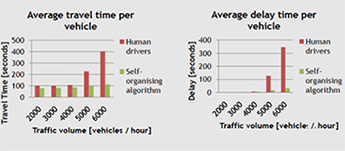Self-organising Motorway Traffic Management
Congestion costs the EU 100 billion Euro per year, while reliable transportation systems are required for just-in-time production and distribution systems. On top of that, lane closures reduce the capacity of a motorway and cause delays and unreliable travel-time estimations.

The goal of this project is to design an algorithm that allows autonomous vehicles to self-organise to mitigate the effects of a lane closure. Once the design is accomplished, an evaluate of the algorithm through simulation is performed. A further step done in order to investigate the practicalities of such a system is the implementation of the algorithm on robots.

Self-organising Motorway
Automated highways tend to increase motorway capacity. One way of automatization is slot-based driving, where vehicles are assigned a position on the road, with a centralised controller co-ordinating traffic. The problem is that existing technologies mainly focus on safety, through systems like adaptive cruise control and lane departure warning.
Self-organisation is a process where a structure or pattern appears in a system without a central authority or external element imposing it through planning (no centralised control or changes to infrastructure)
Novel Self-organising Algorithm
Our algorithm proposes autonomous vehicles categorised by lane number. The vehicles are enabled for vehicle-to-vehicle communication, while being organized in virtual slots. These virtual slots designate a grid around each vehicle, and as a result the vehicle should maintain its position relative to other vehicles.
 Fig 1. 5000 vehicles per hour -Human drivers
Fig 1. 5000 vehicles per hour -Human drivers
 Fig 2. 5000 vehicles per hour –Self-organising algorithm
Fig 2. 5000 vehicles per hour –Self-organising algorithm

